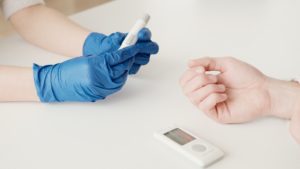
At-home pregnancy testing has been around since the late 1970s, and these handy tests expedited and revolutionized the way that couples found out they were expecting. They work by sampling the urine for a hormone that is found during pregnancy. And they’ve worked so well that the technology is now moving to give couples answers before they ever try to conceive.
Today, hormone testing has advanced to the point that results can show whether your reproductive system is functioning properly. This testing was once only available inside a specialist’s office, but today has been made available to patients inside their homes for a fraction of the cost.
If you’ve ever been curious about your fertility, you may be contemplating purchasing one of these at-home fertility test kits, a relatively new option available for both men and women. These kits allow you to collect samples from the privacy of your own home and receive confidential results.
But when looking online, there are a lot of at-home testing choices out there, so how do you pick the one that’s right for you? In this guide, we’ll talk about the different sample collection methods used in at-home fertility test kits and help you make an informed decision.
There’s more than one way to test your fertility. Let’s cover some common collection methods used in at-home fertility testing.
Collecting a urine sample is straightforward. Most women have taken a pregnancy test at some point in their lives, and some have even been into a doctor’s office and been asked to pee in a cup. Your urine can tell you a lot about your body. At-home pregnancy tests use urine to detect hCG, a hormone produced during pregnancy; this becomes detectible about ten days after conception.
hCG won’t help you determine your fertility, though. So which hormones can be measured through a urine sample? Luteinizing hormone (LH) and estrogen are two reproductive hormones that are detectible in your pee. These two hormones are helpful in identifying normal ovulation or detecting a problem with the process.
Many over-the-counter ovulation predictor kits (OPKs) measure the amount of LH in your urine to provide accurate feedback about your ovulation. They work by detecting an LH surge, an indication that ovulation will occur soon. In order to obtain accurate results, you must repeat the test over a period of five to ten days, which can get expensive quickly and take several months to determine whether your body is ovulating regularly.
As you can see, testing fertility with urine will only tell you so much. Your blood tells a different story. That’s why other methods are sometimes used in at-home fertility test kits, such as a dried blood spot (DBS) filter card. These work by a finger prick done at home and squeezing a small amount of blood onto a collection card and then allowing it to dry. You’ll send the card back into the lab for analysis and results.
This type of test can be used to measure your FSH (follicle-stimulating hormone) levels, an indication of a woman’s ovarian reserve. The accuracy of dried blood spot testing varies, so if you have an abnormal result, testing may need to be repeated in order to confirm your result.
A more accurate method of collecting blood samples for at-home fertility testing is called volumetric absorptive micro sampling, or VAMS. This is a very precise sample collection method because it uses a special collection device that measures an exact amount of blood.
Other advantages to the VAMS collection method include no dry-time, cost-effectiveness, and minimally invasive. VAMS technology can be used to test your fertility hormones, including: LH, FSH, and prolactin. High prolactin levels can disrupt ovulation.
The same technology can be used to test male reproductive hormones, including testosterone and PSA (prostate specific antigen) levels. In addition, hemoglobin A1C levels are often an indication of male fertility, as unhealthy blood sugar levels can affect sperm health.
My Virtual Physician has partnered with Orchid to provide at-home fertility testing to our patients. Orchid trusts and depends on VAMS technology to collect blood samples in their at-home fertility test kits. Find more information about their fertility tests below:
Finally, if you want a comprehensive view of your fertility, you’ve got to take a look at both parties involved: male and female. The best way to test for male fertility is through a semen analysis. Now, at-home sperm collection can be done and sent to a lab. Sperm is collected into a cup and mixed with a preservative, put into a temperature control pack, and shipped to the lab. This sample can be tested for sperm count, motility (movement), shape, and more. Here’s a link to Orchid’s sperm collection kit.
If you’re curious about your fertility and are looking for an accurate snapshot of whether your reproductive system is working properly, we recommend comprehensive testing. For women, that means a VAMS-collected blood test for an accurate measure of hormone levels, and for men, a sperm sample.
While urine samples and DBS cards are options for specific hormones, VAMS sample methods are more accurate and more versatile. Whichever method you choose, we recommend having your results reviewed by a physician.
My Virtual Physician has partnered with Orchid to provide patients with fertility support and feedback following an abnormal fertility result. If you’re interested in getting your fertility tested, schedule an appointment today with My Virtual Physician to order your test kit.
Book Appointment Now Call For An Appointment